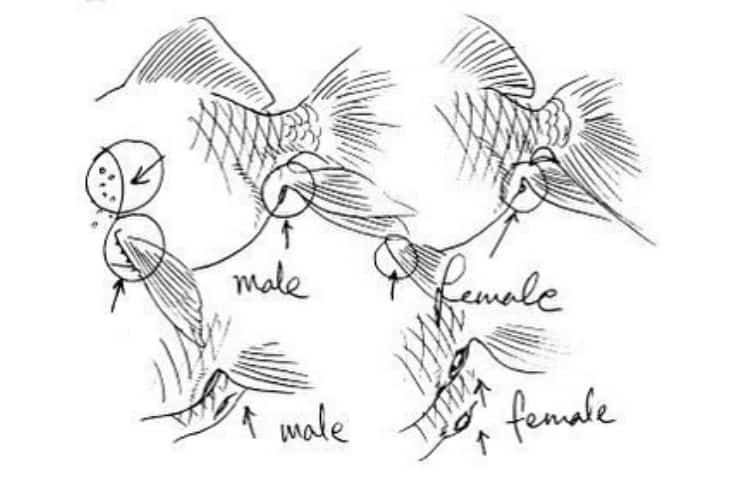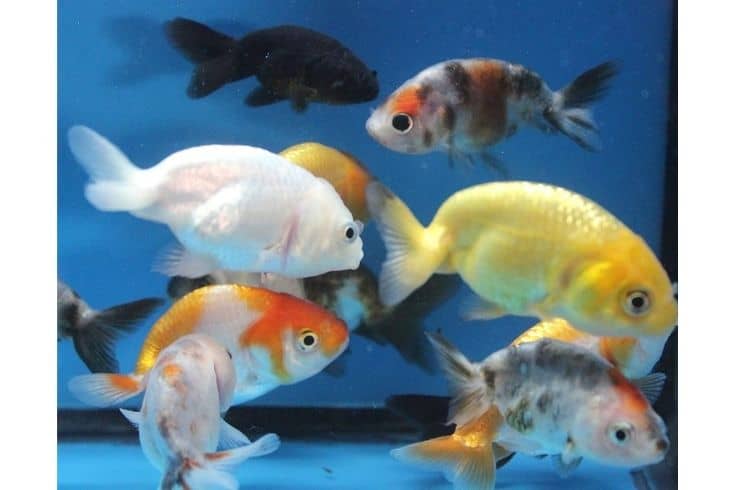Goldfish are one of the most popular pets in the world, and their cheerful appearance and wide range of colors make them a favorite among fishkeepers. Some people breed goldfish for the sheer joy of watching the fry grow up, while professional breeders do it as a career.
But before you can successfully breed your goldfish, you need to be able to tell whether your fish are male or female. This article will discuss the key differences between male and female goldfish and how you can tell them apart.
Ways To Tell If A Goldfish Is Male Or Female
As we’ve previously discussed, there are several ways to tell if a goldfish is male or female. Here are some of the most common methods:
Look at the fish’s belly
Males tend to have thinner, pointier bellies than females. This is because they have a pair of testes located behind their vent (the opening used for both excreting waste and spawning), which causes their bellies to bulge outwards slightly. On the other hand, females tend to have a thicker body shape because they have fuller bellies.
Of course, this method is not foolproof, as there will always be some overlap between male and female bellies. Additionally, if your fish is overweight, this method may not work at all, as all common goldfish will display a fuller body shape. However, if you have a healthy, slender pet, this is generally a pretty good indicator of goldfish gender.
Understand The Differences In Gonadal Development
The easiest way to tell the difference between male and female goldfish is by looking at their gonads (reproductive organs). In males, the gonads are usually located closer to the fish’s vent, and they will look like a pair of small, white balls. Females, on the other hand, have Gonads located further away from the vent, and they will look like a long, white tube.
Of course, this method is not always reliable, as there are some exceptions. For example, young goldfish have undeveloped gonads that may be difficult to identify. Additionally, if your fish has a condition known as “cryptorchidism,” their gonads may not be visible.
Nonetheless, if you have a mature goldfish and can see their gonads clearly, this is generally the best way to tell the difference between male and female goldfish.
Look for Physical Differences In the Vent Area

Another way to determine a goldfish’s gender is to look at its vent, which is located just behind the base of its tailfin. Female goldfish have convex vents that protrude slightly out of their bodies. These can resemble a tiny raised bump. On the other hand, concave vents are typically associated with males, and can look like a little notch in your pets’ bodies.
If you have trouble seeing your fish’s vent, you can try gently lifting its tailfin up and out of the way. However, be careful not to damage the tailfin, and don’t hold the fish out of the water for too long, as it can cause stress and make it more difficult for the fish to breathe. We recommend only doing this for a few seconds at most.
Look for Breeding Tubercles
If you are hoping to breed your goldfish, you will need to look for small white bumps on the leading edges of their pectoral fins. These bumps are called breeding tubercles (sometimes known as breeding stars), and they only appear on male goldfish during breeding seasons (generally late spring to early summer). If you see these tubercles on your goldfish, then you can be fairly certain that it is a male.
Of course, breeding tubercles are only present during spawning season, so if it is not currently spawning season, then this method will not work. Additionally, some female fish may develop very small breeding tubercles, so this method is not foolproof. However, it is probably a male if you see large, clearly defined tubercles on your goldfish’s pectoral fins.
Observe the fish’s behavior

Behavior in goldfish can differ dramatically depending on their genders. Males are generally much more active than females, and they are also more likely to chase other fish (including other males). Additionally, males often display aggression towards each other by nipping at each other’s fins. On the other hand, females tend to be much more passive, and they are less likely to chase or nip at other fish.
Of course, there is always some overlap between male and female behaviors, so this method is not foolproof. Additionally, some goldfish (particularly those not fully grown) may display aggressive and passive behaviors, so it can be difficult to tell their gender based on behavior alone. However, if you observe your fish over a period of time, you should be able to get a good idea of its general behavior, which can help determine its gender.
Look For A Midline Ridge
One of the best ways to tell if a goldfish is male or female is to look for a midline ridge. This ridge is a raised area of scales that extends from the base of the fish’s tail all the way to its head. It is generally more pronounced in males than females, and it can be a good indicator of gender, especially in larger goldfish.
Of course, not all males will have a pronounced midline ridge, and some females may also have a slight ridge. Younger fish may not have developed a ridge yet, so this method is not foolproof. However, if you can see a clear ridge on your goldfish’s body, then it is more likely to be male.
Get A Professional Opinion

If you are still unsure of your goldfish’s gender, the best thing to do is take it to a professional. A veterinarian or a fish breeder should be able to discern your goldfish’s gender with a high degree of accuracy.
While this method is generally reliable, it can be expensive and may not be feasible for everyone. Additionally, some veterinarians or fish breeders may not be willing to determine a goldfish’s gender unless you plan to breed it. However, if you are able to find someone willing to help, then this is by far the best way to determine a goldfish’s gender.
FAQs
At What Age Do Goldfish Start Breeding?
The breeding age of goldfish can vary depending on the species. Common goldfish, for example, typically start breeding when they are 2-3 years old, while fancy goldfish such as the shubunkin generally start breeding when they are 3-4 years old.
However, some goldfish (particularly those that are not fully grown) may start to breed at an earlier age. If you are unsure of your goldfish’s breeding age, then it is best to consult a professional.
How Do Goldfish Breed?
Sexual characteristics in fish breeding can be very different from those in mammals. For example, goldfish do not have nipples, and they do not give live birth. Instead, goldfish reproduce by releasing eggs and sperm into the water, where the eggs are fertilized.
Once the eggs are fertilized, they sink to the bottom of the tank and hatch within a few days. The fry (baby goldfish) then spend the next few weeks hiding in plants and other structures, where they are safe from predators. After a few weeks, the fry will start to venture out into the open water, and they will gradually begin to look like miniature versions of their adult counterparts.
What Kind Of Breeding Technologies Exist For Goldfish?
Goldfish breeding has come a long way in recent years, and there are now several different technologies that can be used to improve the quality of goldfish offspring. For example, many breeders now use genetic testing to ensure that their goldfish have the desired traits. They may look for traits such as color, pattern, fin type, and even resistance against common goldfish diseases.
Other breeding technologies sometimes used include in vitro fertilization (IVF) and embryo transfer. IVF is a process in which eggs are fertilized outside of the body, and then the resulting embryos are transferred to the female. This allows breeders to control the genetic makeup of their goldfish more precisely, which can be especially vital if you’re sexing a rare or expensive goldfish species.
Embryo transfer is similar to IVF, but it involves transferring embryos that have already been fertilized. This allows breeders to produce larger numbers of fry with the same genetic makeup.
Final Thoughts
There are many reasons you might want to know the gender of your goldfish. If you plan to breed your goldfish, for example, it is important to know which fish are male and which are female. Additionally, if you are simply curious about your goldfish’s gender, there is no harm in finding out. We hope that this article has helped you to determine the gender of your goldfish. Good luck!
Did you find this article helpful? If you did, please consider sharing it with your friends or family. Thanks for reading!
